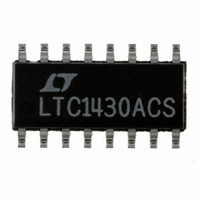LTC1430ACS Linear Technology, LTC1430ACS Datasheet - Page 14

LTC1430ACS
Manufacturer Part Number
LTC1430ACS
Description
IC SW REG CNTRLR STEP-DWN 16SOIC
Manufacturer
Linear Technology
Type
Step-Down (Buck)r
Datasheet
1.LTC1430ACS8.pdf
(24 pages)
Specifications of LTC1430ACS
Internal Switch(s)
No
Synchronous Rectifier
Yes
Number Of Outputs
1
Voltage - Output
3.3V, Adj
Current - Output
50A
Frequency - Switching
50kHz ~ 500kHz
Voltage - Input
4 ~ 8 V
Operating Temperature
0°C ~ 70°C
Mounting Type
Surface Mount
Package / Case
16-SOIC (3.9mm Width)
Lead Free Status / RoHS Status
Contains lead / RoHS non-compliant
Power - Output
-
Available stocks
Company
Part Number
Manufacturer
Quantity
Price
Company:
Part Number:
LTC1430ACS8
Manufacturer:
LT
Quantity:
10 000
Part Number:
LTC1430ACS8
Manufacturer:
LINEAR/凌特
Quantity:
20 000
Company:
Part Number:
LTC1430ACS8#TRPBF
Manufacturer:
LINEAR
Quantity:
12 711
LTC1430A
A
properly with an RC network from COMP to GND and an
additional small C from COMP to GND (Figure 11). Loop
stability is affected by inductor and output capacitor
values and by other factors. Optimum loop response can
be obtained by using a network analyzer to find the loop
poles and zeros; nearly as effective and a lot easier is to
empirically tweak the R
looks right with an output load step. Table 1 shows
recommended compensation components for 5V to 3.3V
applications based on the inductor and output capacitor
values. The values were calculated using multiple paral-
leled 330 F AVX TPS series surface mount tantalum
capacitors as the output capacitor.
Table 1. Recommended Compensation Network for 5V to 3.3V
Application Using Multiple 330 F AVX Output Capacitors
Output transient response is set by three major factors: the
time constant of the inductor and the output capacitor, the
ESR of the output capacitor, and the loop compensation
components. The first two factors usually have much
more impact on overall transient recovery time than the
third; unless the loop compensation is way off, more
improvement can be had by optimizing the inductor and
the output capacitor than by fiddling with the loop com-
pensation components. In general, a smaller value induc-
tor will improve transient response at the expense of ripple
14
PPLICATI
L1 ( H)
2.7
2.7
2.7
2.7
5.6
5.6
5.6
5.6
10
10
10
10
1
1
1
1
C
OUT
1980
4950
9900
1980
4950
9900
1980
4950
9900
1980
4950
9900
990
990
990
990
O
( F)
U
S
C
values until the transient recovery
R
I FOR ATIO
C
180
1.8
3.6
9.1
3.6
7.5
9.1
18
18
39
18
47
91
18
39
91
U
(k )
W
C
0.0047
0.0022
0.0047
0.0022
0.0047
0.0022
0.0022
820pF
470pF
470pF
220pF
0.022
0.001
0.001
C
0.01
0.01
( F)
U
C1 (pF)
820
470
150
470
220
150
82
82
39
82
33
15
82
39
15
10
and inductor core saturation rating. Minimizing output
capacitor ESR will also help optimize output transient
response. See Input and Output Capacitors for more
information.
Soft Start and Current Limit
The 16-lead versions of the LTC1430A include a soft start
circuit at the SS pin; this circuit is used both for initial start-
up and during current limit operation. The soft start and
current limit circuitry is disabled in the 8-lead version. SS
requires an external capacitor to GND with the value
determined by the required soft start time. An internal
12 A current source is included to charge the external
capacitor. Soft start functions by clamping the maximum
voltage that the COMP pin can swing to, thereby control-
ling the duty cycle (Figure 12). The LTC1430A will begin to
operate at low duty cycle as the SS pin rises to about 2V
below V
increase until the error amplifier takes over and begins to
regulate the output. When SS reaches 1V below V
CC
. As SS continues to rise, the duty cycle will
Figure 12. Soft Start Clamps COMP Pin
Figure 11. Compensation Pin Hook-Up
C
COMP
SS
SS
GND
V
R
CC
C
C
LTC1430A
LTC1430A
C
12 A
COMP
SGND
FB
1430 F12
C1
1430 F11
CC
the














